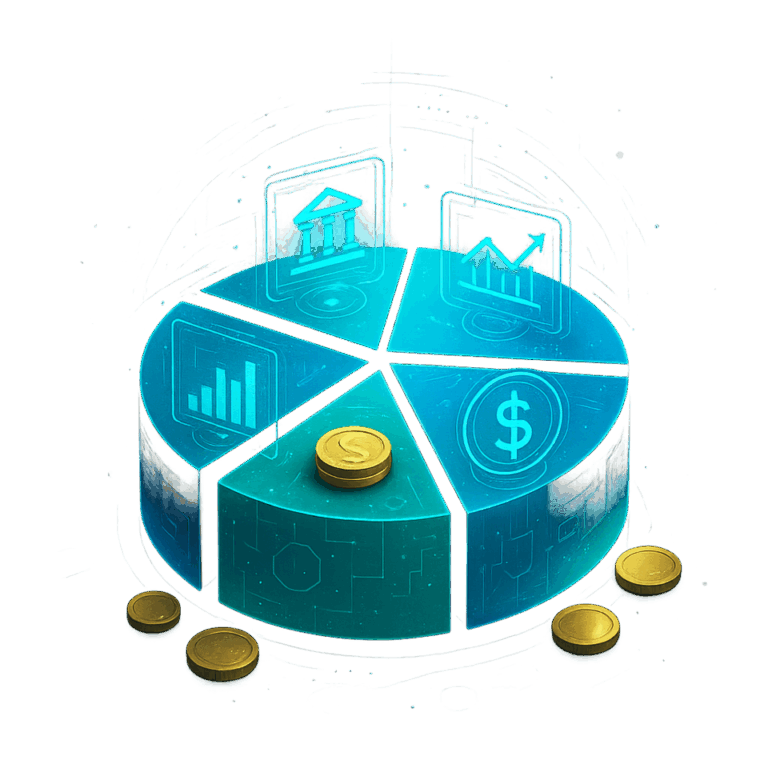As we navigate through 2025, the financial landscape has entered a new era—one defined by digital transformation, decentralized systems, and consumer empowerment. The traditional banking model, once dominated by physical branches and slow bureaucratic processes, has evolved into a highly dynamic digital ecosystem. In this environment, fintech startups, blockchain networks, and artificial intelligence are collectively reshaping how individuals and businesses manage, move, and multiply money.
The growing adoption of digital finance ecosystems signifies a fundamental shift in global financial infrastructure. What began as an alternative to conventional banking has now become a mainstream movement, accelerating inclusion, innovation, and efficiency across borders. This article explores the evolution of digital finance ecosystems, their impact on consumers and businesses, the crucial role of blockchain, and what the future holds for the financial world as technology continues to blur the lines between traditional banking and decentralized finance.
The Evolution of Banking in the Digital Age
Over the past decade, the banking sector has undergone a dramatic transformation driven by technological innovation and changing consumer expectations. The rise of fintech—financial technology—has redefined what customers expect from financial services. Between 2020 and 2025, the proportion of global consumers using at least one fintech product surged from 30% to nearly 70%, according to industry reports.
This transformation reflects not only an appetite for convenience but also a demand for transparency and personalization. Traditional banks, once viewed as pillars of financial stability, have faced mounting competition from nimble, digital-first challengers. In response, they have adopted hybrid models that combine trusted legacy systems with cutting-edge innovations such as mobile banking, AI-driven customer service, and open banking APIs.
In 2025, most major banks operate in partnership with fintech companies, offering digital wallets, instant loan approvals, and real-time investment management tools. Yet, beyond digitization lies a deeper revolution—one that decentralizes finance altogether through blockchain technology and peer-to-peer systems that challenge the need for intermediaries.
The Role of Blockchain in Financial Ecosystems
Blockchain technology stands at the core of the digital finance revolution. As a decentralized ledger that records transactions securely and transparently, blockchain has introduced new levels of trust and efficiency to the financial system. By 2025, more than 60% of financial institutions worldwide are either piloting or fully integrating blockchain-based solutions.
The applications of blockchain in finance are vast and transformative. Cross-border payments, once plagued by delays and high transaction fees, can now be completed in minutes using blockchain infrastructure. Smart contracts—self-executing agreements coded directly into digital ledgers—automate processes such as insurance claims, loan approvals, and trade settlements without the need for manual intervention.
One of the most important outcomes of blockchain adoption is cost reduction. Traditional global remittance systems charge an average fee of 6% per transaction, whereas blockchain-powered payments can reduce this to under 1%. Additionally, blockchain’s immutable structure prevents fraud and improves compliance through real-time verification and traceability.
Blockchain has also paved the way for decentralized finance (DeFi), a financial system that operates without intermediaries. In 2025, the DeFi market exceeds $250 billion in total value locked (TVL), offering services such as lending, borrowing, staking, and trading through smart contracts. These decentralized platforms are democratizing access to financial tools previously reserved for institutional investors.
The Impact of Digital Finance on Consumers
For consumers, digital finance ecosystems have redefined the very concept of money management. Digital wallets, mobile banking apps, and cryptocurrencies have empowered individuals to take greater control over their financial lives. In 2025, approximately 40% of global consumers use digital wallets or crypto-based payment systems for everyday purchases, from groceries to utilities.
This shift toward digital transactions has been accompanied by an increase in financial literacy. Fintech platforms offer not only services but also education, helping users understand investments, credit management, and financial planning. Robo-advisors, for instance, have made investing more accessible than ever. With low entry barriers and automated strategies, they allow anyone with an internet connection to build diversified portfolios tailored to their goals and risk profiles.
Moreover, digital finance ecosystems have enhanced inclusivity. In regions where access to traditional banking was limited, mobile payment systems and peer-to-peer lending apps have bridged the gap. In Africa and Southeast Asia, mobile money platforms such as M-Pesa and GCash have become essential tools for financial empowerment, particularly among rural populations.
Security and privacy, once major concerns, have improved considerably thanks to advancements in encryption, biometric authentication, and regulatory oversight. Consumers now enjoy faster transactions, greater transparency, and reduced reliance on physical currency—all while maintaining higher levels of financial security than ever before.
The Business Perspective: Opportunities and Challenges
Businesses across industries are reaping the benefits of digital finance ecosystems. Blockchain-based supply chain management systems provide real-time tracking, ensuring authenticity and reducing fraud. For example, global manufacturers use blockchain to verify the origin of raw materials, while retailers apply it to ensure ethical sourcing and transparency.
Payment automation and digital invoicing have streamlined business operations. Small and medium-sized enterprises (SMEs), traditionally underserved by banks, can now access decentralized financing and crowdfunding platforms that connect them directly to global investors. These systems minimize delays, eliminate excessive fees, and promote innovation-driven entrepreneurship.
However, businesses must also navigate significant challenges. The rapid pace of technological advancement demands continuous adaptation and investment in digital infrastructure. Cybersecurity threats remain a top concern, particularly as the integration of digital finance increases exposure to data breaches and phishing attacks.
Regulatory compliance adds another layer of complexity. In 2025, over half of fintech startups report encountering regulatory barriers that hinder their expansion into international markets. Governments are working to harmonize digital finance regulations, but differing national frameworks continue to create friction. Successful businesses are those that strike a balance between innovation, compliance, and customer trust.
The Future of Digital Finance Ecosystems
The future of digital finance lies in integration, interoperability, and intelligence. By 2025, blockchain networks, artificial intelligence, and big data analytics are converging to create an ecosystem that is not only digital but also predictive and adaptive.
Artificial intelligence plays a critical role in this evolution. AI algorithms can analyze consumer behavior, predict financial trends, and personalize financial products. For instance, banks use AI-driven analytics to assess creditworthiness in real time, enabling instant loan approvals based on behavioral data rather than outdated credit scores. Similarly, AI chatbots offer 24/7 customer assistance, improving accessibility and satisfaction.
The convergence of AI and blockchain also enhances cybersecurity. Machine learning models detect suspicious patterns within blockchain transactions, identifying fraud before it occurs. This synergy creates a robust and transparent system capable of protecting users without compromising decentralization.
Another major trend shaping the future is interoperability among blockchain systems. In earlier years, blockchain networks operated in isolation, limiting their utility. In 2025, however, cross-chain protocols enable seamless interaction between different blockchains, creating a unified digital finance environment. This allows assets to move freely across platforms, increasing liquidity and efficiency.
Tokenization of assets is another defining trend. Real estate, commodities, and even artwork can now be represented as digital tokens, making them more liquid and accessible to a global audience. This process allows fractional ownership, lowering entry barriers for investors and opening new opportunities for wealth creation.
Regulatory Perspectives and Consumer Protection
As the digital finance ecosystem expands, the role of regulators becomes increasingly vital. Governments worldwide are implementing policies to ensure financial stability, data protection, and fair competition. The European Union’s MiCA (Markets in Crypto-Assets) regulation, for example, provides a comprehensive framework for crypto assets and digital finance. Its goal is to promote innovation while ensuring consumer protection and market integrity.
In the United States, regulatory agencies are working toward a balanced approach, encouraging fintech innovation while safeguarding against systemic risks. Countries in Asia, particularly Singapore and Japan, have become leaders in developing clear regulatory guidelines that attract digital finance investments without compromising oversight.
Consumer protection is a central theme in this evolving landscape. As financial interactions become increasingly digital, protecting users from fraud, data misuse, and volatility is essential. Transparent disclosure practices, digital identity verification systems, and blockchain-based audit trails are among the measures ensuring accountability.
At the same time, governments are using digital finance tools to promote inclusion. Central Bank Digital Currencies (CBDCs), now active in over 40 countries, offer secure, low-cost payment options accessible even to unbanked populations. By merging regulation and innovation, policymakers are building financial systems that are both future-ready and socially responsible.
Sustainability and Ethical Finance in the Digital Era
Sustainability is emerging as a cornerstone of digital finance in 2025. Investors and companies alike are aligning financial activities with environmental and social objectives. Blockchain technology enhances this movement by enabling transparent tracking of sustainable initiatives, such as carbon credits and renewable energy projects.
Fintech firms are integrating ESG (Environmental, Social, and Governance) metrics into their platforms, allowing users to invest in projects that align with their values. Digital ecosystems now support micro-investments in green technologies, making sustainability-driven investing accessible to millions worldwide.
Additionally, AI-driven analytics help companies measure the real-world impact of their sustainability goals. This combination of transparency, accountability, and accessibility ensures that digital finance ecosystems contribute not only to economic growth but also to the well-being of the planet.
Conclusion
The rise of digital finance ecosystems in 2025 marks one of the most significant transformations in modern economic history. What began as a technological experiment has evolved into a global movement redefining how we think about money, trust, and inclusion. Blockchain technology, fintech innovation, and artificial intelligence have together created a more efficient, secure, and accessible financial world.
For consumers, this evolution brings greater freedom and empowerment. For businesses, it offers efficiency and global reach. For governments and regulators, it demands collaboration, foresight, and adaptability. The convergence of these elements will continue to shape a financial ecosystem that is not only digital but also democratic and sustainable.
As we look ahead, one thing is clear: the future of finance is decentralized, data-driven, and inclusive. The continued rise of digital finance ecosystems will not only redefine economic opportunity but also determine how societies around the world achieve prosperity in the digital age.



